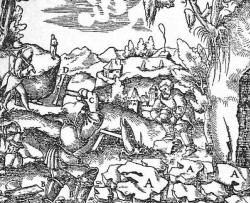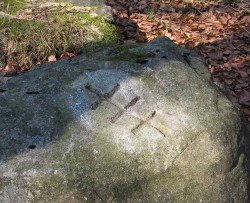Walloons

Walloons -
are old-time mineral and precious stones hunters, who arrived in the
Karkonosze and the Jizera Mountains. The
name included:
"... any
foreign Venetians, Florentines, or other Walloons, who searched the
mountains as mountain men, gem hunters, or glass experts."
The
Walloon "capital" was the Stara Wieś Szklarska - now part
of Lower Szklarska Poreba. A
settlement was
established here with a chapel on the Orla Skała, an inn and the
Judicial Linden tree. The
Walloons
pointed out local deposits of quartz for smelters. The
earliest glassworks is mentioned in the document of 08.07.1366, as
one that 'has long been located in Szklarska Poreba'. At the bank of
the Kamienna River, there was a manufacturing plant, where sulfuric
acid was made of shale pyrite.
Not
far from the Szklarka waterfall, the Walloons had discovered deposits
of smoky quartz, and in the Kamienna valley gold and
amethysts. Particular
importance was assigned to the Wobbling Stone,
which was easy to rock, and - according to Walloon legends - closed
access to the hidden treasures.
Nowadays,
there are two specialist museums open in Szklarska Poreba: the
Mineralogical Museum (Marysin, 20 J. Kilińskiego St.) and the Museum
of the Earth (Middle Szklarska Poreba, Jeleniogórska highway 9).
Also, "the Brotherhood of the Walloon in the Sudetes"
operates actively, cultivating the old traditions and rituals.

The trail leads from Lower Szklarska Poreba, from the cemetery church of Our Lady of the Rosary (convenient parkinglots are also found here), near the Judiciary Linden, next to the location of the earliest glass factory, via the Kamieńczyk valley, then through the Szklarki waterfall, Old Cottage Walloon, the Museum of the Earth, Hofman Wlastimil Museum, Golden View, Tomb of Karkonosz, the Wobbling Stone, and back to the parking lot in Lower Szklarska Poreba.
It is an easy trail, accessible to all visitors regardless of age and degree of preparation, lavishly illustrated with boards with interesting descriptions of the trail, marked in red. "The Trail of the Walloon" was further described in a small guide with a situational map attached to it, which is available in the Department of Town Promotion in the center of Szklarska Poreba, 1A Jedności Narodowej St.
Another attraction is the opportunity to taste the delights of the Walloon, served in some of the local restaurants and bakeries. A list of places with Walloon delicacies is found below.
The course ofthe Trail

"Judicial Linden" in Stara Wieś Szklarska - the oldest part of Szklarska Poreba, founded in the early 14th century, in its early days associated with Walloon precious stones and minerals hunters, as well as with glass-making. Over time, a village was established in this location, with an inn and the Judical Linden - a place where the mayor made local laws.
"The Church of Our Lady of the Rosary", the oldest remaining church in Szklarska Poreba, dating back to around 1650. On the southern and western wall there are Baroque and Classicist tombstones of the Preussler family - founders and owners of the local glassworks.
"The oldest glass factory" in the lower area of the Szklarski Potok the oldest glass factory was located, mentioned in a document dated 08/07/1366, as one that 'has long been located in Szklarska Poreba'. The Walloons pointed out deposits of quartz to local smelters, which were the main raw material for melting glass.
"Eagle Rock" According to local tradition, there was a small pilgrimage chapel here in the Middle Ages, with a miraculous image of the Blessed Virgin. It was a place visited by the Walloons before heading to the mountains.
"Stróżna", a granite rock associated with the peasant rebellion in the years 1587-1589, which also included the Schaffgots lands near Jelenia Gora. For almost two years, the peasants had defended access to Lower Szklarska Poreba by blocking the road. Until 1945 it has been a monument of nature.

Sulfuric acid plant ("Witriolejnia") making sulfuric acid from shale pyrite. By the early 19th century this was the largest such plant in Prussia. Pyrite, also called "the fool's gold", was mined in nearby tunnels located near the Rogue Rocks.
"Kamienna River" took its name from its rocky riverbed. The Walloons mined gold and precious stones in Kamienna and its tributaries. This is evidenced by the names of streams, "Czarna Płóczka" (the Black Panning), "Półcznik" (Panner), "Złoty Potok" (Golden Stream), "Szafirowa Struga" (Sapphire Stream), and "Rudnik"(Ore Stream).
"Szklarka waterfall", where the rare, smoky quartz - highly valued in the Middle Ages - was mined by Walloon seekers of minerals and gemstones.
"Old Cottage Walloon" - seat of the Grand Master of the Walloon Brotherhood in the Sudetes. The Sudetes Walloon Brotherhood was created on 19/09/1999. It gathers minerals and precious stones seekers, as well as the lovers of the history of the region.
"Red Cave" - an old bed of pegmatites. The proposed chapel of St. Lawrence, patron saint of Walloon minerals and precious stones hunters, whose feast is celebrated annually on 10 August.
"Museum of the Earth" - it is possible to see and purchase minerals of Karkonosze, the Jizera Mountains, and also from other parts of the world. Next to it, there is the Dungeon Inn with regional Walloon dishes as well as Walloon Museum - a reconstructed Walloon panning site on Czeska Struga, used to mine gold and precious stones.
"House Wlastimil Hofman" In this house - now a museum - in the years 1947-1970, lived Wlastimil Hofman "the painter of the internal light," the greatest artistic individuality of postwar Karkonosze.
"Tomb of Karkonosz" Here the Spirit Mountain - Karkonosz, driven by bad people from his age-old domain under Równia pod Śnieżką, looking at his beloved mountains, died of grief and found his final resting place.
"The Golden View" - Panorama of Karkonosze from Śnieżka through Słoneczniki, the Long Ridge, the Great Helmet, Snow Cirques, Łabska Peak all the way to Szrenica. Since the Middle Ages, this was a place frequented by the Walloons, mountaineers and tourists.
"The Wobbling Stone" - a granite boulder, easy to rock, which according to legend closes the access to hidden treasures. The Wobbling Stone was of special importance for the seekers of minerals and precious stones. Regarded as the place from which Walloons took off to their expedition after completing appropriate ceremonies.
Walloon treats
- Walloon Cake - Restaurant "Metafora", 1 Objazdowa St.
- Walloon Pierogi - Karkonoska Inn, 11, 1-go Maja St.
- Walloon Sour Rye Soup - Restaurant "Kaprys", 12 Jedności Narodowej St.
- Walloon Bread - Piekarnia Państwa Kukiełka, "The Mountain Bakery" of Mr. and Mrs. Raźny, 10 Jedności Narodowej St.
- Regional Walloon Butter Cake - "Under the Clock" Bakery of Mr. and Mrs. Stochaj, 1 Jedności Narodowej St.
- Walloon Pretzels and the Walloon Pâté - Bakery of Mr. and Mrs. Baca, 2 Chopina St.







